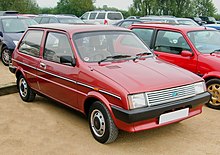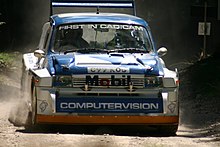Mini metro
The Mini Metro was a car model of the English car manufacturer British Leyland . It was built from summer 1980 to spring 1994 by the Austin Motor Company and until autumn 1997 by the Rover Group and marketed under the brand names Austin, Rover and MG .
Basic models
The Metro was originally launched as the successor to the popular Mini . Just like the Mini in its day, the Metro was also designed in a progressive manner. The Metro was the first vehicle in which the rear back seat could be divided into a single and a double seat. Divisible rear seats were also available before, but not with the 1/3-2 / 3 division, which is now available in many vehicles with foldable rear seats.
The Metro was bigger than the Mini and from autumn 1985 it was also available as a five-door. The drive was based on the technology of the Mini, which, however, had undergone some changes. The engines had 998 cm³ (33 kW) and 1,275 cm³ (46 kW) as well as 70 kW for the Metro Turbo. Since the 1275 cm³ engine was only installed again (in a modified form) in the metro and the Mini was only delivered with the 998 cm³ engine at that time, many metros and metro turbos have been degraded to organ donors and now with their original motorization only very rarely found. The chassis was equipped with a Hydragas composite suspension, which was a further development of the Mini-Hydrolastic suspension.
The Metro was also available in a van version. This had a normal body, but the rear side windows (C-windows) were missing.
While the Metro went on sale as the Rover 100 in Germany and many other export markets after the facelift in spring 1990 , production of the original Mini continued for another ten years.
In Great Britain the name Metro remained until the spring of 1994. It was only adapted to the other markets in the course of a further revision.
Metro 6R4
The MG Metro 6R4 was designed in 1984 for the short-lived Group B of rallying, had a 6-cylinder mid-engine and four-wheel drive. The competition vehicle was only vaguely similar to the normal Metro, it had all-wheel drive and only had two seats. The development was entrusted to Williams Grand Prix Engineering .
The Metro 6R4 was presented in May 1985. It was powered by a 3-liter V6 DOHC engine installed lengthways with four valves per cylinder. The machine differed from most of its competitors in that it did not have a turbocharger. The body was made of plastic, but the doors were made of sheet steel. However, the latter were provided with plastic panels that supplied the mid-engine with air. Show models these days have stickers that indicate where the vehicle can be pushed safely without damaging the body.
The 6R4 appeared in two versions: There was a so-called Clubman model, the engine of which developed around 184 kW and of which around 200 were manufactured. Of these, 20 evolution copies were prepared according to the rules of the FIA, which among other things made it possible to install a 279 kW engine.
When the car came out in 1985, Rover announced that it would produce the necessary number of items for homologation (200 units) by November of that year. This happened in the largest MG rover factory in Longbridge. At the Lombard RAC rally in November 1985, Tony Pond took a respectable third place with this vehicle behind two Lancia Delta S4s .
However, the initial successes did not continue. Although the 6R4s were used in the 1986 rallies in Monte Carlo, Sweden, Portugal and Corsica, none of the cars used made it to the finish. Most of the problems were caused by the teething troublesome V6 engine. Since then, there have been many allegations that the engine was not fully developed before it was used in competitions. At the end of the 1986 season, Group B was banned from the World Rally Championship by the FIA after both the driver and spectators were killed in a series of accidents. From then on, the 6R4 models were no longer successful, although they were still in use later in the year. Some examples went into private hands and were later used as excellent rally and rallycross cars. The Briton Will Gollop became European Rallycross Champion in 1992 with an almost 700 hp MG Metro 6R4 BiTurbo.
Austin Rover retired from the rally scene at the end of the 1986 season. In 1987, all parts and engines were sold to Tom Walkinshaw Racing, after which the V6 engine was used again under the hood of the Jaguar XJ220 , this time equipped with two turbochargers.
"I know it's an ugly beast, but the 6R4 is easily the best rally car I've ever driven."
"I know he's an ugly beast, but the 6R4 is by far the best rally car I've ever driven."
See also
Web links
Individual evidence
- ↑ Marijan Malcevic: MG Metro 6R4 - the unique Group B monster. In: snaplap.net. September 10, 2015, accessed June 6, 2018 .





